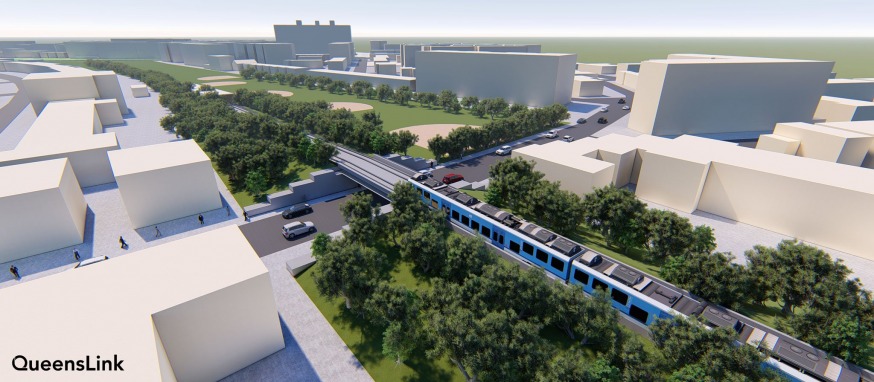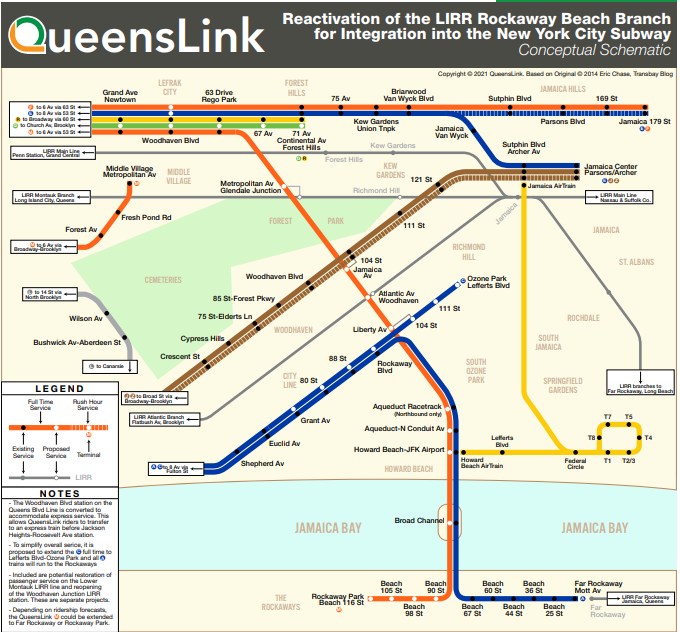
More than a dozen Queens elected officials have called on the city and state to fund a study that would assess the viability of a north-south train line in central Queens. Rendering of the QueensLink proposal (QueensLink)
Aug. 8, 2022 By Michael Dorgan
More than a dozen Queens elected officials have called on the city and state to fund a study that that would assess the viability of a new potential north-south train line in central Queens.
The call comes from 15 electeds who support exploring the feasibility of a massive project dubbed the QueensLink Corridor. The proposal, if implemented, would create a north-south train line through central Queens that would connect Rego Park to Ozone Park by extending the M line. The line would use 3.5 miles of abandoned LIRR tracks that were once part of the Rockaway Beach Branch line.
The line could also be extended south to Rockaway Park.
The electeds say that the QueensLink Corridor would benefit the borough in many ways including improving access to public transport for residents living in Glendale, Woodhaven, Richmond Hill, Howard Beach, Broad Channel and the Rockaways. They say the project would also help reduce carbon emissions and spur economic growth along the route.
The 15 electeds penned a letter to Gov. Kathy Hochul and Mayor Eric Adams Thursday urging them to secure funds to pay for an Environmental Impact Study (EIS) for the QueensLink Corridor.
The letter was signed by Congressman Gregory Meeks, State Senators James Sanders, Jessica Ramos and Joseph Addabbo, as well as Assembly Members Stacey Pheffer Amato, David Weprin, Andrew Hevesi, Khaleel Anderson, Jennifer Gonzalez-Rojas and Jenifer Rajkumar.
Queens Borough President Donovan Richards also signed the letter, as did Councilmembers Nantasha Williams, Robert Holden, Selvena Brooks-Powers and Joann Ariola. CB 6 Chair Heather Dimitriadis and CB 14 Chair Delores Orr joined the electeds in signing the letter.
The signees wrote that the study was necessary in order for officials to get a complete understanding of the challenges and opportunities the project would face.
“An EIS would provide greater detail on QueensLink’s potential economic and environmental impact, as well as provide solutions to preserve the quality of life for people and businesses along the right-of-way,” the letter reads.
The signees urged Hochul and Adams to tap into funds that were included in the federal Infrastructure Bill to pay for the study. Around $10 billion from the bill has been apportioned to infrastructure projects throughout the state, they wrote. The legislation was signed into law by President Biden in November.
The QueensLink project proposes rerouting the M line southbound from the 63rd Drive – Rego Park station along a new 3.5-mile rail where the idle LIRR tracks lay. The new M rail would connect to the Liberty Avenue station at a minimum. It could then be extended to Rockaway Park — replacing the shuttle train that runs from Broad Channel to Beach 116th Street.
The project also proposes extending the G train to Forest Hills in place of the rerouted M train.

QueensLink proposed train map (QueensLink/ TEMS study)
Pheffer Amato said funding for the EIS study is needed since the project would bolster public transport in southern Queens if it were built.
“QueensLink is the transportation project my community needs,” said Pheffer Amato, who represents District 23 covering Broad Channel, Hamilton Beach, Howard Beach, Lindenwood, Ozone Park and the Rockaway Peninsula.
“My community for far too long has faced the label of a transit desert because we have not seen the true investment in transportation that we deserve.”
The call for the EIS study comes after the MTA published a study looking at the cost and feasibility of the project in 2019. The study, completed by Systra Engineering, estimated the cost would be about $8.1 billion.
However, a study commissioned by QueensLink supporters and released by transportation firm TEMS Inc. last year found the cost to be between $3.4 and $3.7 billion.
Nevertheless, the signees of the letter said the cost of the project would be recouped since around 50,000 riders a day would use the service. The TEMS study also found that the creation of the QueensLink would create up to 150,00 new jobs over the course of its lifetime.
“QueensLink is an investment that could pay for itself in economic return in less than a decade while serving New York City for generations,” the letter reads.
The signees likened the project to the “Interborough Express” or the “IBX,” a mass transit proposal that would convert an existing 14-mile freight line — running from Jackson Heights to Sunset Park in Brooklyn.
“The QueensLink is to South and Central Queens what the IBX is proposed to be for Brooklyn and Western Queens,” the letter reads. “Both projects would reuse existing rail assets to improve mass transit for neighborhoods that desperately need it, while simultaneously reducing carbon emissions.”
Meanwhile, Holden said QueensLink was a “common sense” project that would help ease traffic congestion on Woodhaven Boulevard and the Van Wyck Expressway.
“I’m very excited about QueensLink as it will provide motorists with a fast, efficient, and environmentally friendly alternative to having to drive on Woodhaven Boulevard and the Van Wyck Expressway,” said Holden, who represents Glendale, Maspeth, Middle Village, Ridgewood, Woodhaven, and Woodside.
“If we’re serious about reducing carbon emissions and making our local roads safer then we have to build the infrastructure to support it.”
The electeds also wrote in the letter that Queenslink would also better connect travelers to various attractions in Queens such as Resorts World, Aqueduct Racetrack, the Rockaways, shopping malls as well as J.F.K Airport.
2 Comments







Larry’s right, building a subway connection is never quick or easy, but nothing of value ever is. Even more of a reason not to waste any more time.
After 60 years, it looks like the political leadership is finally in place to objectively evaluate how this skinny strip of land can help 47,000+ people access better schools, jobs, and recreation. Just as important is making sure that local communities are not negatively impacted, and in fact, benefit from new parks and other amenities.
We welcome Larry and others who benefit from efficient rail transportation to get onboard! We can use all the help we can get.
http://www.QueensLink.org
More is needed besides lobbying Governor Kathy Hochul and Mayor Eric Adams for funding to pay for a future environmental review under the federal National Environmental Protection Act (NEPA). This task could cost millions of dollars. MTA Chairman Janno Lieber must be convinced to serve as project sponsor. Hochul and Adams need to instruct their respective MTA Board members to request the same. The MTA needs to obtain permission from the Federal Transit Administration to enter this project under the FTA national competitive discretionary Capital Investment Grants (CIG) New Starts Core Capacity Grant program. This is the same program that funded MTA’s $11.2 billion LIRR East Side Access to Grand Central Terminal (now known as Grand Central Madison) and NYC Transit $4.5 billion Second Avenue Subway Phase 1. Financing construction would require a FTA Full Funding Grant Agreement (FFGA). The total project, be it $3, $8 billion, or more would require the MTA providing between 50% to 66% local share necessary to leverage the balance of federal dollars. It averages five or more years from admission into the FTA CIG program before a transit agency successfully completes the process and obtains federal funding under a FFGA grant
(Larry Penner — transportation advocate, historian and writer who previously worked for the Federal Transit Administration Region 2 New York Office. This included the development, review, approval and oversight for billions in capital projects and programs for the MTA, NYC Transit, Long Island & Metro North Rail Roads MTA Bus, NYC DOT, New Jersey Transit along with 30 other transit agencies in NY & NJ)..